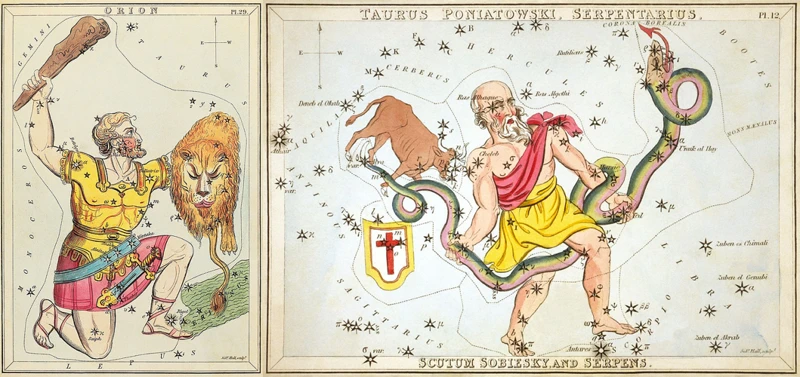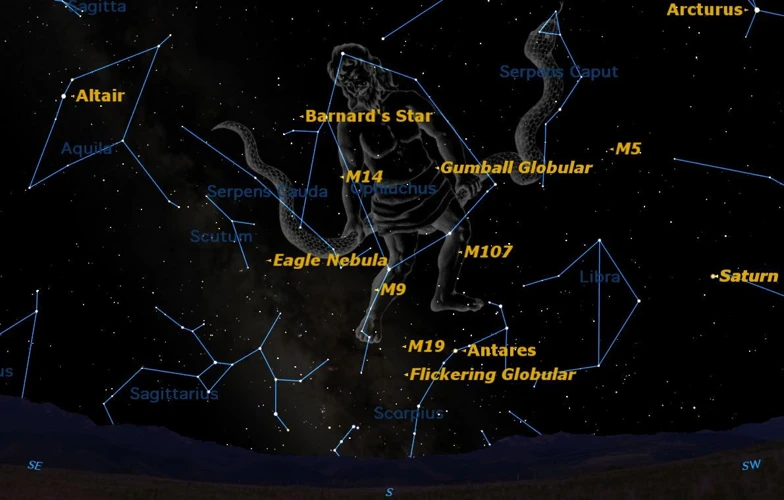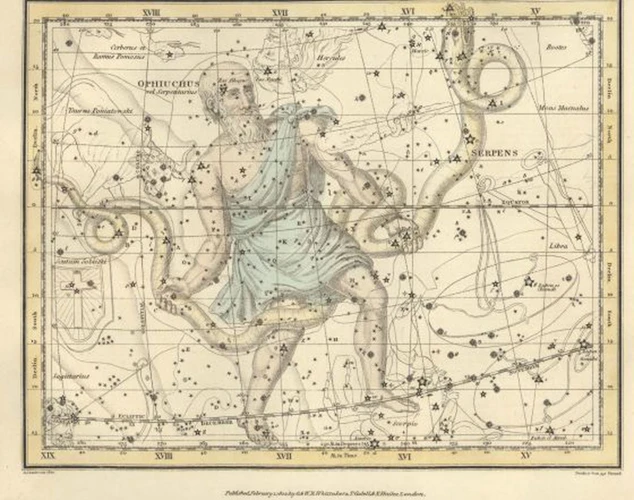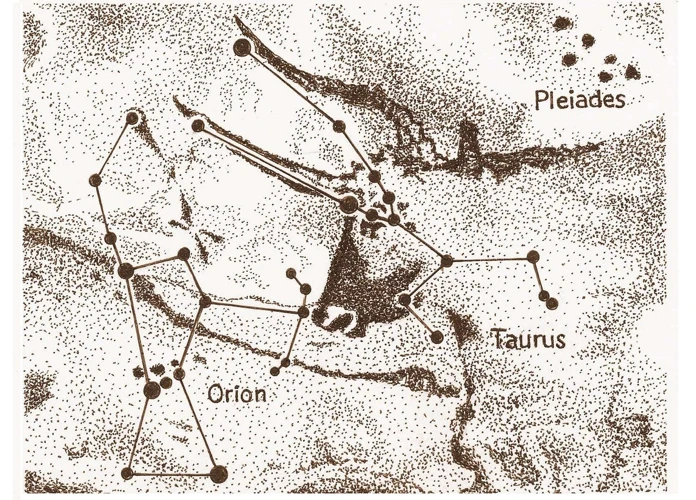For centuries, the Pleiades have captured the imagination of civilizations around the world. This enigmatic cluster of stars, also known as the Seven Sisters, has been shrouded in mystery, inspiring ancient myths and legends. While these tales provide us with a glimpse into the beliefs and cultures of our ancestors, modern science has also delved into the secrets held by the Pleiades. Through scientific research and technological advancements, we are beginning to unravel the mysteries of this stellar cluster, shedding light on its distance, formation, and composition. In this article, we will explore the connections between myth and science, and delve into the enigma of the Pleiades, discussing new research directions and future studies that may bring us closer to understanding this enduring celestial wonder.
Ancient Myths and Legends

The ancient myths and legends surrounding the Pleiades are as diverse as the cultures that revered them. Known as the Seven Sisters, these stars have captured the imaginations of people worldwide. In Greek mythology, the Pleiades were said to be the daughters of Atlas and Pleione, transformed into stars by the gods to escape the advances of the Orion1. The Pleiades also play a significant role in the mythology of many Native American tribes, who see them as a cluster of seven young women or spirits. In Japanese folklore, the Pleiades are called Subaru, meaning “to gather together,” symbolizing the unity and strength of the cluster. These ancient stories continue to inspire wonder and fascination, weaving a tapestry of celestial mystery that spans cultures and time.
The Seven Sisters
The Pleiades, often referred to as the Seven Sisters, have a prominent place in ancient myths and legends. In Greek mythology, the Pleiades were the daughters of Atlas and Pleione. The seven sisters were Alcyone, Asterope, Celaeno, Electra, Maia, Merope, and Taygete. According to the myth, after their father Atlas was forced to hold up the sky, the gods transformed the sisters into stars to protect them from the advances of the hunter Orion, who also became a constellation in the night sky. The Pleiades can be seen as a tight cluster of stars in the Taurus constellation, and their striking beauty has captured the attention of civilizations around the world throughout history. These sisters serve as a symbol of unity, strength, and sisterhood in many cultures, exemplifying the power of familial bonds and female relationships. The story of the Seven Sisters continues to inspire and enchant, reminding us of the enduring power of mythology in our human experience.
Pleiades in Ancient Cultures
In ancient cultures around the world, the Pleiades held special significance and were incorporated into various mythologies and belief systems. In Greek mythology, the Pleiades were believed to be the seven daughters of the Titan Atlas and the Oceanid Pleione. The name “Pleiades” itself comes from Greek, meaning “to sail” or “to be crowded.” The Pleiades were associated with stories of love, tragedy, and transformation. They were often depicted as a group of young women, dancing and frolicking together. The connection between the Pleiades and the story of the hero Hercules is noteworthy. According to one myth, Hercules was assigned a task to capture the sacred bull who roamed freely through the land. As a reward for completing this task, Hercules was granted a place among the stars, and his image was immortalized in the constellation Taurus, near the Pleiades1. In other cultures, the Pleiades played different roles. For instance, in Greek mythology, the Pleiades were associated with the enigmatic constellation Orion. The star Alcyone, one of the Pleiades, was said to be the mother of Orion2. Additionally, the Pleiades were also linked to the legendary winged horse, Pegasus. In some tales, it is said that Pegasus was born from the blood spilled from Medusa’s severed head, and when Pegasus ascended to the heavens, he placed himself near the Pleiades3. These ancient tales and beliefs speak to the enduring fascination and reverence that the Pleiades held in ancient cultures, showcasing their influence in shaping the narratives and cosmologies of civilizations around the world.
/ancient-stories-hercules-heroic-labors-constellation/
Scientific Research and Discoveries

Scientific research and discoveries have propelled our understanding of the Pleiades beyond ancient myths and into the realm of hard facts. Astronomers have studied this stellar cluster extensively, using advanced telescopes and instruments to unravel its mysteries. Through meticulous observations, they have determined that the Pleiades is located approximately 444 light-years away from Earth, making it one of the closest star clusters to our solar system. Additionally, the Pleiades consists of hundreds of stars, with the most prominent seven being hot, young, and blue in color. However, there are also fainter and cooler stars within the cluster. Scientists have also discovered that the Pleiades is a relatively young cluster, with an age of around 100 million years. Its youthfulness is evident in the presence of dazzling nebulous clouds and ongoing star formation activity within its boundaries. These scientific discoveries have not only unraveled the distance, formation, and composition of the Pleiades but have also posed new questions, paving the way for further exploration and deeper understanding of this celestial enigma.
Studying the Stellar Cluster
Studying the stellar cluster of the Pleiades has been an ongoing endeavor for astronomers and scientists. Through the use of advanced telescopes and spectroscopic techniques, researchers have been able to unravel some of the secrets held by this captivating group of stars. One aspect of studying the Pleiades involves determining their precise distance from Earth, which has been a subject of debate over the years. By measuring the parallax of individual stars within the cluster and employing trigonometric calculations, astronomers have estimated that the Pleiades is located approximately 440 light-years away from us. Another intriguing aspect is the formation of the Pleiades cluster. Researchers believe that these stars were born from the same molecular cloud, with their formation occurring about 100 million years ago. By studying the age and motion of the stars within the Pleiades, scientists can gather valuable insights into the evolution and dynamics of stellar clusters. Spectroscopic analysis has offered insights into the composition of the Pleiades stars. By analyzing the light emitted by the stars, astronomers have determined their chemical composition, including elements such as hydrogen, helium, and traces of other elements. The study of the Pleiades cluster continues to provide valuable data and expand our understanding of the formation and characteristics of stellar groups in our universe.
Distance, Formation, and Composition
As we delve into the mysteries of the Pleiades, one of the key aspects that intrigues scientists is understanding the distance, formation, and composition of this enigmatic cluster. The Pleiades, located in the constellation of Taurus, are approximately 440 light-years away from Earth1. With such a vast distance, studying the cluster poses unique challenges. Scientists have employed various techniques, including parallax measurements and spectroscopy, to estimate the distance and determine the cluster’s three-dimensional structure.
In terms of formation, the Pleiades are believed to have originated from a single molecular cloud around 100 million years ago. This cloud of gas and dust collapsed under its own gravity, giving birth to both the stars of the Pleiades and the surrounding reflection nebulae that add to their ethereal beauty. The Pleiades cluster consists of hundreds of stars, with the brightest stars being hot blue stars, known as B-type stars1. Despite their similar formation and age, these stars exhibit a wide range of properties, including variations in mass, size, and temperature.
The composition of the Pleiades cluster is another intriguing aspect of scientific research. Through spectroscopy, scientists have analyzed the light emitted by the stars and identified various elements present. The Pleiades stars are primarily composed of hydrogen and helium, with traces of other elements such as oxygen, carbon, and nitrogen. These elemental compositions provide valuable insights into the evolution and chemical enrichment processes within the cluster1.
Understanding the distance, formation, and composition of the Pleiades is crucial for unraveling the mysteries of this stellar cluster. By studying these aspects, scientists can gain a deeper understanding of the cluster’s origins, evolution, and its place within the vast cosmos.
1 Source: mythology-orions-belt
Mysteries and Variability of the Pleiades
The Pleiades, with their shimmering beauty, hold within them a multitude of mysteries and variability that continue to intrigue astronomers and scientists. One of the most perplexing aspects of the Pleiades is their peculiar brightness. While these stars appear dazzlingly bright to the naked eye, they exhibit a wide range of luminosities when observed more closely. This variability raises questions about the nature and characteristics of the stars within the cluster. Astronomers have discovered that some of the Pleiades stars are more massive and hotter than our Sun, while others are smaller and cooler. This discrepancy in size and temperature contributes to the varied brightness observed in the Pleiades. Another intriguing aspect is their lifespan. The Pleiades are relatively young stars, estimated to be around 100 million years old. However, some of the stars within the cluster display anomalies in their age, which has puzzled scientists. These irregularities in age suggest that there might have been multiple episodes of star formation within the Pleiades. Researchers continue to investigate the origins of these enigmatic patterns, and the mysteries surrounding the variability of the Pleiades serve as a reminder that the universe still holds many secrets waiting to be unraveled. [Source: /enigmatic-history-pegasus/]
Connections Between Myth and Science

The connections between myth and science regarding the Pleiades are intriguing and thought-provoking. Exploring the symbolism and influence of these ancient myths, we begin to appreciate how human perception of celestial phenomena has shaped our understanding of the universe. Ancient civilizations possessed a remarkable level of astronomical knowledge, reflected in their stories and legends. The Pleiades often represented concepts such as fertility, navigation, and timekeeping. Modern interpretations and astronomical theories have shed light on the scientific aspects underlying these myths. For example, scientific studies have revealed that the Pleiades cluster is actually a gravitationally bound group of young stars, formed from a common molecular cloud. This newfound knowledge allows us to appreciate the union of myth and science, recognizing the importance of cultural interpretations while also unraveling the mysteries of the cosmos.
Exploring the Symbolism and Influence
Exploring the symbolism and influence of the Pleiades reveals the profound impact they have had on cultures throughout history. In ancient mythologies, the Pleiades often represented a group of celestial beings, serving as symbols of beauty, femininity, and fertility. The cluster was considered sacred and associated with deities such as Artemis and Aphrodite in Greek mythology1. The Pleiades’ rising and setting were related to agricultural cycles, heralding the arrival of the planting season or marking the time for harvest in various cultures. The influence of the Pleiades extended beyond mythology and agriculture, permeating art, literature, and even modern popular culture. Artists depicted the Pleiades in beautiful paintings, and writers immortalized them in literature as symbols of inspiration and guidance. The Pleiades constellation serves as a navigational tool, guiding sailors and travelers across the globe for centuries. Even today, the Pleiades continue to captivate and inspire astronomers, artists, and dreamers alike, their influence transcending time and connecting us to our ancient roots and the wonders of the universe.
Ancient Astronomical Knowledge
Ancient cultures possessed a remarkable understanding of astronomy, evident in their observations and interpretations of celestial phenomena such as the Pleiades. The recorded knowledge of ancient astronomers provides us with valuable insights into their perceptions of the universe. In ancient Egypt, the rising of the Pleiades marked the beginning of the new year and was a key element in determining the annual flooding of the Nile River, which played a vital role in agriculture and society2. The Mayans, renowned for their sophisticated astronomical knowledge, incorporated the Pleiades into their calendars and associated them with agricultural cycles. They believed that the Pleiades influenced plant growth and sowing times3. Ancient astronomers in China regarded the Pleiades as an important marker in the night sky, with their observations helping to establish the Chinese lunisolar calendar and contributing to astronomical predictions4. These examples illustrate the profound significance ancient cultures attributed to the Pleiades and how they integrated their astronomical knowledge into various aspects of their lives and societies. The myths and beliefs surrounding the Pleiades were deeply intertwined with ancient astronomical observations, reflecting the reverence and fascination these cultures had for the celestial realm.
Modern Interpretations and Astronomical Theories
Modern interpretations and astronomical theories surrounding the Pleiades have provided fascinating insights into the nature of this stellar cluster. One widely accepted theory is that the Pleiades formed from a single molecular cloud of gas and dust, about 100 million years ago. This theory suggests that the stars within the cluster are gravitationally bound to one another, with their positions and velocities tracing back to a common origin point. Astronomers have observed that the Pleiades are a relatively young cluster, as many of its stars are still in the early stages of their evolution.
Another theory proposes that the Pleiades are not simply a loose collection of stars, but rather a dynamically evolving system. This theory suggests that the cluster is a gravitationally unstable system, with interactions between stars causing them to be ejected over time. This dynamic nature could explain why the Pleiades appear scattered across the sky instead of clustered tightly together.
Scientists have studied the spectral properties of the Pleiades stars to understand their composition and evolutionary stage. By analyzing their spectra, astronomers have found that the Pleiades stars share a similar chemical composition, indicating a common origin and evolution. Additionally, variations in the spectra have revealed clues about the age and rotation rates of the stars within the cluster.
In recent years, there has been an increasing focus on the study of exoplanets within the Pleiades cluster. Astronomers have used advanced techniques, such as high-resolution spectroscopy and transit observations, to search for planets around Pleiades stars. While no confirmed exoplanets have been discovered within the cluster thus far, ongoing research is shedding light on the potential for planetary systems within star clusters.
Modern interpretations and astronomical theories provide a deeper understanding of the Pleiades, their formation, and their evolution. They allow scientists to piece together the puzzle of this intriguing stellar cluster and unravel its mysteries.
Unraveling the Pleiades Enigma
Unraveling the enigma of the Pleiades is an ongoing endeavor that combines scientific research, technological advancements, and a quest for knowledge. New research directions are constantly being explored to uncover the secrets of this celestial phenomenon. One key area of focus is the study of the Pleiades’ motion and dynamics within our galaxy. By examining their trajectories and velocities, scientists hope to gain insight into their formation and evolution. Another approach involves advancements in telescope technology. High-resolution imaging allows astronomers to observe the individual stars within the Pleiades cluster, revealing their varying sizes, temperatures, and compositions. These advancements, coupled with ongoing studies of the Pleiades’ magnetic fields, stellar ages, and exoplanets, offer promising avenues for unraveling the mysteries that surround this captivating stellar cluster. As scientists continue to push the boundaries of knowledge, the enigma of the Pleiades draws closer to being unraveled, giving us a deeper understanding of the universe we inhabit.
New Research Directions
As our understanding of the Pleiades expands, new research directions are being pursued to uncover even deeper insights into this celestial phenomenon. One such area of exploration involves the use of advanced telescopes and imaging techniques to study the individual stars within the cluster. By analyzing their spectra and variations in brightness, scientists hope to gain a better understanding of their properties, such as temperature, mass, and age. Additionally, researchers are investigating the possibility of finding exoplanets within the vicinity of the Pleiades stars, expanding our knowledge of planetary formation and the potential for habitable worlds. Another exciting avenue of research is the study of the Pleiades’ connection to other stellar clusters and the broader galactic environment. By comparing their characteristics and movements, astronomers can unravel the intricate web of stellar evolution and uncover clues about the formation and evolution of galaxies themselves. These new research directions hold the promise of revealing deeper secrets about the Pleiades and the universe at large, furthering our understanding of the mysteries that lie beyond our own world.
Technology Advancements and Future Studies
As technology continues to advance at an exponential rate, so too does our ability to study and unravel the secrets of the Pleiades. One of the most significant advancements in recent years has been the development of powerful telescopes and imaging techniques. These cutting-edge technologies allow astronomers to observe the Pleiades with unprecedented detail and clarity, revealing intricate structures and variations within the cluster. Additionally, advancements in spectroscopy have enabled scientists to analyze the composition of the stars in the Pleiades, offering insights into their chemical makeup and evolutionary history.
Another area of future study lies in the field of astrometry. Astrometry involves precisely measuring the positions and motions of celestial objects, which can help determine the distance and dynamics of the Pleiades. With the launch of space-based astrometry missions such as the Gaia spacecraft, scientists have access to unprecedented levels of accuracy and precision in measuring the properties of stars within the cluster. By combining data from astrometry missions with other observational techniques, astronomers hope to unravel the complex dynamics and formation history of the Pleiades.
Advancements in computational modeling and simulation techniques have allowed scientists to create sophisticated models of star formation and cluster evolution. By inputting observational data and theoretical assumptions, these simulations can provide insights into the processes that led to the formation of the Pleiades and their current structure. As computational power increases and our understanding of stellar dynamics deepens, these models will become even more refined and accurate, enabling us to better comprehend the mysteries of the Pleiades.
The future of studying the Pleiades is bright, thanks to the continuous advancements in technology and the development of new observational and analytical techniques. With telescopes, imaging tools, spectroscopy, astrometry, and computational modeling at our disposal, we are poised to uncover even more mysteries about the Pleiades and gain a deeper understanding of the stellar cluster’s origins, composition, and evolution.
Keywords: technology advancements, future studies, telescopes, imaging techniques, spectroscopy, astrometry, computational modeling, simulation techniques, star formation, cluster evolution
Conclusion
The Pleiades, with their ancient myths and modern scientific discoveries, continue to intrigue and captivate us. In conclusion, the intertwining of ancient myths and modern science reveals the enduring power of human curiosity and the interplay between culture and astronomy. The stories of the Seven Sisters have influenced diverse cultures across the globe, showcasing the universal human fascination with the stars. Scientific research has deepened our understanding of the Pleiades, uncovering their distance, formation, and composition. However, many mysteries and variabilities still exist, leaving room for further exploration and new research directions. The Pleiades remain an enigma waiting to be fully unraveled, with future studies fueled by advancing technologies offering promising insights into this celestial wonder. As we continue to bridge the gap between myth and science, the Pleiades stand as a testament to the vast expanse of knowledge yet to be discovered in our universe.
Key Points:
– The Pleiades blend ancient myths and modern scientific discoveries.
– The stories surrounding the Pleiades span across different cultures worldwide.
– Scientific research has shed light on the distance, formation, and composition of the Pleiades.
– Mysteries and variabilities within the Pleiades remain to be fully understood.
– Future studies fueled by technological advancements hold promise in unraveling the enigma of the Pleiades.
– The Pleiades symbolize the enduring fascination humans have with the cosmos.
Frequently Asked Questions
What is the significance of the Pleiades in ancient mythology?
In ancient mythology, the Pleiades held great significance across various cultures. They were often associated with fertility, protection, and the cycle of life. Many mythologies depict the Pleiades as a group of celestial sisters or maidens with their own unique stories and roles.
Are there any specific stories or legends associated with the Pleiades?
Yes, there are several captivating stories tied to the Pleiades. From Greek mythology’s tale of the seven sisters being pursued by Orion, to Native American folklore that views them as guiding spirits or ancestors, each culture added their own rich narratives to these celestial stars.
How far away are the Pleiades?
The Pleiades star cluster is located approximately 440 light-years away from Earth. The light we currently observe from the Pleiades actually left the cluster over four centuries ago, providing us with a glimpse into its past.
What is the composition of the Pleiades?
The Pleiades are composed of hot, young stars primarily made up of hydrogen. These stars are relatively young, with an estimated age of around 100 million years.
Why do the Pleiades appear to vary in brightness?
The variability in brightness of the Pleiades is due to a combination of factors, such as differences in size, temperature, and evolution of the stars within the cluster. Additionally, interstellar dust and gas can also influence their apparent brightness.
Did ancient civilizations have knowledge of the Pleiades’ movements?
Ancient civilizations were keen observers of the night sky and recognized the Pleiades as a prominent star cluster. They carefully tracked its movements and associated it with seasonal changes, agricultural patterns, and celestial events.
What advancements in technology have aided in the study of the Pleiades?
Technological advancements, specifically in telescopes and imaging techniques, have greatly aided the study of the Pleiades. These advancements have allowed scientists to observe the cluster in different wavelengths, revealing valuable insights into its structure, dynamics, and individual stars.
What ongoing research is being conducted on the Pleiades?
Current research on the Pleiades focuses on unraveling the cluster’s intricate dynamics, studying the formation and evolution of its stars, and exploring any planets or other objects that may reside within it. Scientists also continue to investigate the fascinating phenomenon of stellar variability within the Pleiades.
Are there any connections between the Pleiades and other constellations?
Yes, the Pleiades cluster is often associated with other well-known constellations. For instance, in Greek mythology, the Pleiades are connected to the constellation Taurus, as the sisters are said to ride on the bull’s back. These connections further enrich the mythology and symbolism surrounding these celestial entities.
What can we learn from studying the ancient myths and modern science of the Pleiades?
Studying both ancient myths and modern science can provide us with a holistic understanding of the Pleiades. It allows us to appreciate the cultural significance and symbolism attributed to these stars while also unraveling the scientific phenomena, dynamics, and mysteries that lie within this captivating stellar cluster.








